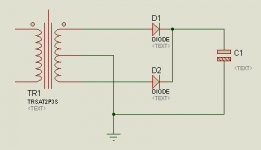Hey, I have the following transformer being used in a system that I am making.
My power supply needs:
250VAC (from one end of the HV to the Center Tap)
6.3VAC (from the far ends of the heater winding)
12VAC (from a separate, non-CT transformer)
Do I need to ground the center tap of the 6.3V winding?
Do I snip off the other HV wire and cover the end?
How can I use a 12VAC transformer with no center tap in this circuit?
Question marks indicate the questionable connections.
Thank you.
An externally hosted image should be here but it was not working when we last tested it.
My power supply needs:
250VAC (from one end of the HV to the Center Tap)
6.3VAC (from the far ends of the heater winding)
12VAC (from a separate, non-CT transformer)
Do I need to ground the center tap of the 6.3V winding?
Do I snip off the other HV wire and cover the end?
How can I use a 12VAC transformer with no center tap in this circuit?
Question marks indicate the questionable connections.
An externally hosted image should be here but it was not working when we last tested it.
Thank you.
6.3 needs no ground. the high voltage windings must be in parallel. the 12v transformer goes the same way.
this is just my opinion but and i am just a beginer so wait for other reply's
this is just my opinion but and i am just a beginer so wait for other reply's
Hi.
With a non center tapped transformer like your 12 volt, you use the bridge rectifier. (four diodes) The AC goes into the top corners of the diamond. the DC comes out the other two. no center tap needed. When making a full wave rectifier with just two diodes, that is when you need the center tap. The anode of one diode goes to each end of the transformers secondary, The cathodes are tied together. that is the positive output of the rectifier. the negative end comes from the center tap. The bridge will give you a peak dc voltage of 1.4 times the transformers secondary minus 2 diode drops. For a fullwave rectifier with the center tapped transformer you get 1.4 times the secondary voltage across both legs of the transformer minus one diode drop.
As for the high voltage if you are using a bridge and don't need the center tap, you should have either a 250 volt non center tapped transformer, or a 125-0 125 and just ignore the tap. don't cut it. you might want to reuse it somewhere else someday.
read up on basic power supply design. lots of info on the web.
Cheers.
Rolf.
With a non center tapped transformer like your 12 volt, you use the bridge rectifier. (four diodes) The AC goes into the top corners of the diamond. the DC comes out the other two. no center tap needed. When making a full wave rectifier with just two diodes, that is when you need the center tap. The anode of one diode goes to each end of the transformers secondary, The cathodes are tied together. that is the positive output of the rectifier. the negative end comes from the center tap. The bridge will give you a peak dc voltage of 1.4 times the transformers secondary minus 2 diode drops. For a fullwave rectifier with the center tapped transformer you get 1.4 times the secondary voltage across both legs of the transformer minus one diode drop.
As for the high voltage if you are using a bridge and don't need the center tap, you should have either a 250 volt non center tapped transformer, or a 125-0 125 and just ignore the tap. don't cut it. you might want to reuse it somewhere else someday.
read up on basic power supply design. lots of info on the web.
Cheers.
Rolf.
You would normally ground the CT of the HV supply and use a dual rectifier tube or 2 silicon diodes.

You can do the same with the 6.3V it will still leave you enough headroom (8.9V) to regulate down.
You can't use a single secondary 12V tx to get +- 15, you will need a CT or dual secondary. You'll only get +-17VDC so although this will work with LDO regulators, you're cutting it a bit fine with 78xx, 79xx series which have 2V dropout voltage, and you have to think about supply voltage fluctuation even with LDO.
w

You can do the same with the 6.3V it will still leave you enough headroom (8.9V) to regulate down.
You can't use a single secondary 12V tx to get +- 15, you will need a CT or dual secondary. You'll only get +-17VDC so although this will work with LDO regulators, you're cutting it a bit fine with 78xx, 79xx series which have 2V dropout voltage, and you have to think about supply voltage fluctuation even with LDO.
w
Good to know. I will purchase a center tapped transformer.
This differential supply will be feeding 12 opamps, so there will be some loading. I will do some calculations to figure what output voltage I need to still get 17V to the VRs.
This differential supply will be feeding 12 opamps, so there will be some loading. I will do some calculations to figure what output voltage I need to still get 17V to the VRs.
- Status
- Not open for further replies.
- Home
- Amplifiers
- Tubes / Valves
- Transformer wiring (Need Help)